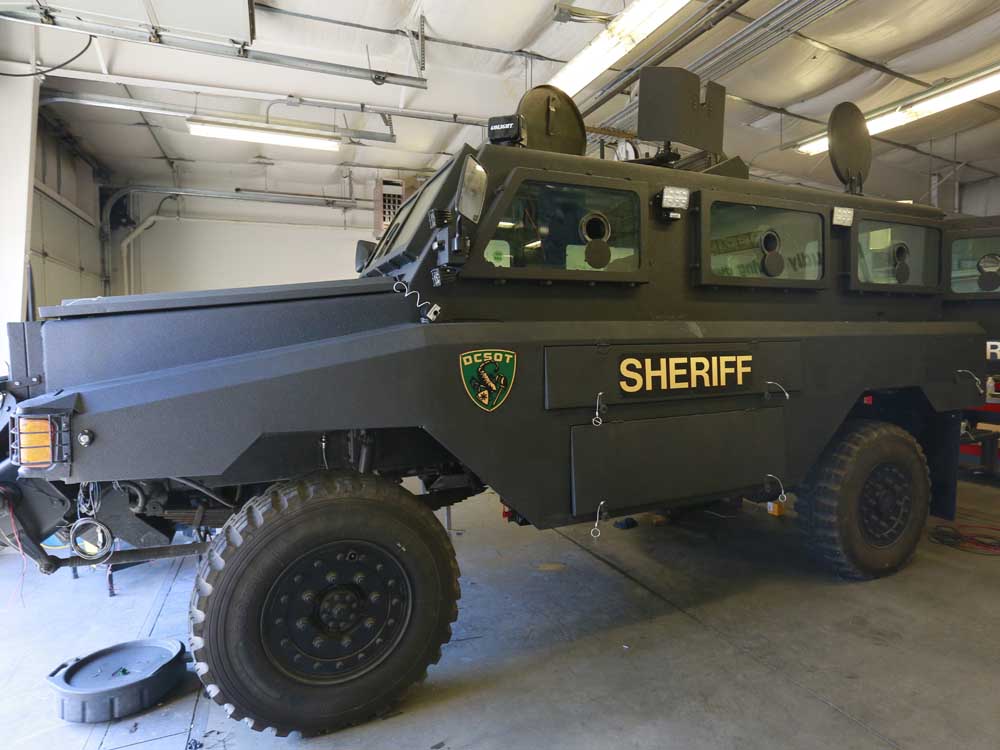Less surplus military gear going to Oregon police
Published 12:00 am Sunday, December 7, 2014

- Joe Kline / The Bulletin An armored vehicle that the Deschutes County Sheriff's Office obtained through a federal program has some repair work done last summer. The the flow of such surplused military gear into Oregon has slowed in recent months amid public scrutiny of police tactics.
Oregon police agencies for years were largely given a green light to stock up on military gear under a program that supplies excess equipment to local law enforcement.
But the flow of that gear into Oregon has slowed in recent months amid public scrutiny of police tactics following high-profile killings by police in Missouri, New York City and Cleveland, and the heavy police response to some protests.
President Barack Obama last week said the federal government would look to tighten standards local police must meet when they apply for and accept gear that has moved from battlefields into communities throughout the country. But documents from Oregon’s program coordinator and others show the Department of Defense didn’t wait for the president before tightening the program. In early November, states agreed to require training plans before the military-grade gear was given out.
Steve Smith, who has overseen Oregon’s program since 2000, said Friday he was waiting to see what impact, if any, the president’s recommendations would have on what’s known as the 1033 Program in addition to the changes already in place.
“The president can make recommendations to it, but from what we see Congress is going to have to make the changes to it,” Smith said.
Five police agencies told The Bulletin they’ve already returned or plan to return the military equipment they received through 1033, though there’s no immediate indication the new scrutiny over policing played a role.
Oregon State Police have returned weapons and an armored vehicle the agency had acquired through the program, according to a spokesman with the department, who didn’t provide an explanation.
The sheriffs’ offices of Douglas and Sherman counties and the Hermiston Police Department will return the M-16 rifles they received through 1033, citing lack of use and impractical and low quality of the weapons. Douglas County will keep its mine-resistant vehicle.
Smith said departments have left the program before and that he didn’t think it had anything to do with the national attention.
The Portland Police Bureau will return most of the rifles it received through 1033, Sgt. Pete Simpson, a department spokesman, said in an email.
The focus on 1033 hasn’t stopped the flow of equipment to local agencies nationwide, according to a spokeswoman at the Defense Logistics Agency, which oversees 1033.
There have been “no changes in the pace of requests, approvals or transfer of equipment,” Michelle McCaskill, a spokeswoman, wrote in an email.
In the months since the initial protests in August after a white police officer killed a black 18-year-old in Ferguson, Missouri, state and local police have faced scrutiny within some communities, the White House and members of Congress over what some said was the over-militarization of local law enforcement.
The protests in the St. Louis suburb in the weeks following Michael Brown’s death were largely peaceful, but police responded with rifles and heavy vehicles. They lobbed tear gas canisters to break up crowds and arrested some journalists who were covering the protests.
The ACLU and more than three dozen other groups called for a moratorium on the 1033 program in October.
“There is very little discussion at the local level about the weapons that they’re obtaining,” said Becky Straus, legislative director of the ACLU-Oregon.
Straus said the ACLU may advocate for citizen panels or legislative committees to oversee the program in Oregon.
In the last five years, the federal government has given thousands of pieces of equipment worth $2.7 billion to local agencies through 1033.
Oregon agencies currently have at least $10.9 million, though it’s difficult to tell how much gear is in the state because some items no longer show up on inventory lists after a year.
The Wheeler County Sheriff’s Department received three trucks at around $40,000 each in late September. The Klamath County Sheriff’s Office received a mine-detecting set worth $19,300 in early October. Baker County received some items such as a tent, shirts and packs. Clackamas County got an outboard motor.
Inventory lists dating to 2006 show Oregon local and county police possess about 3,700 of pieces of equipment, down about 800 in the last three months.
The Deschutes County Sheriff’s Office has about $385,000 in equipment, including a REVA Armored Vehicle. The Bend Police Department has about $5,700 in guns.
Smith said he doesn’t track denials, but that he rarely turns down requests if departments can show that they aren’t asking for too much.
“Normally if it looks a little screwy to me I’ll call them up and say ‘Hey, what are you doing with this?’” Smith said. “As long as they have a logical reason for it then I’ll go ahead and approve it.”
He added that although the state was suspended from the program for a month in recent years, no department is currently suspended from 1033.
Spokesmen for state coordinators in other Western states such as Washington, California, Idaho, Nevada and New Mexico generally said the only time an agency would be denied equipment would be if it was clear a department had no need for a piece of gear.
The president’s recommended changes included after-incident reports filed when the equipment is used in part to combat what the White House said was a lack of accountability and oversight of the gear.
Some departments in Oregon said in August they were unable to recall specific times their vehicles were used.
— Reporter: 406-589-4347,
tanderson@bendbulletin.com






